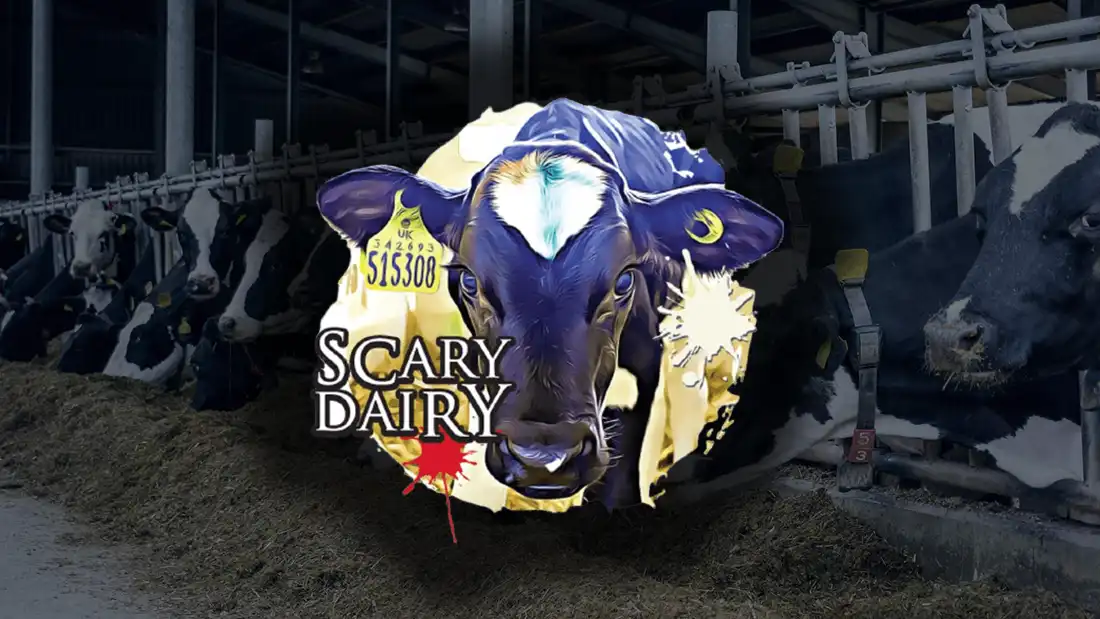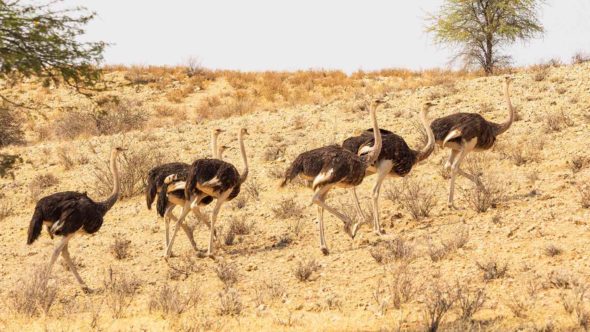How Ostriches Are Farmed and Killed

- Ostriches can go without water for days by extracting fluid from the plants they eat. If water is available, they do like to drink a fair amount.6National Geographic, 2020. Ostrich. Available at https://www.nationalgeographic.com/animals/birds/o/ostrich/ [Accessed 16 July 2020].
- Ostrich eggs are the world’s largest eggs and can be up to 150 mm in length and 125 mm in diameter.7Encyclopaedia Britannica, 2020. Ostrich. Available at https://www.britannica.com/animal/ostrich [Accessed 16 July 2020]. They can also weigh up to 1.5 kilos.8African Wildlife Foundation, 2020. Ostrich. Available at https://www.awf.org/wildlife-conservation/ostrich [Accessed 16 July 2020].
- Ostriches have extraordinary eyesight – their eyes being 5cm across and having three sets of eyelids, helping them to spot predators from a long distance.9Travel Africa, 2020. 13 Fun Fact about Ostriches. Available at https://travelafricamag.com/13-fun-facts-about-ostriches/. [Accessed 16 July 2020].
- To protect themselves, ostriches press their neck and head to the ground (though not in it!), attempting to become invisible as their plumage blends in well with their natural habitat of sandy soil and rocks.10National Geographic, 2020. Ostrich. Available at https://www.nationalgeographic.com/animals/birds/o/ostrich/ [Accessed 16 July 2020]. And this is probably where the expression ‘burying your head in the sand’ comes from.
- Unlike all other living birds, ostriches secrete urine separately from faeces.
- The ostrich is the world’s largest bird. They stand at 2 to 3 metres tall (6 to 9 feet).
- Flightless birds are birds that lost the ability to fly through evolution. There are over 60 living species, including the ostrich and other ratites (emu, cassowaries, rheas and kiwi) and penguins.
- There are two living species of ostrich – the common ostrich (Struthio camelus) and the Somali ostrich (Struthio molybdophanes).
Ostriches – the oldest living bird on earth

Ostriches are African nomads, designed by 60 million years of evolution to roam over vast tracts of grassland and desert. They are the only bird to have two-toed feet which are cloven, like camels, with well-padded soles designed for exploring the hot desert and for running at speed.
Speed is their main self-defence, along with a formidable karate kick. Ostriches always kick forwards and down, lifting their feet as high as a person’s face and with its large single claw, this mighty bird can disembowel a person with one downward thrust. Not surprisingly, they are officially classed as Dangerous Wild Animals.
Ostriches have beautiful, big brown eyes and their upper eyelids have tiny feathers, which resemble long eyelashes. They protect their eyes from the fierce glare of the desert sun.
On the open veld, the ostrich’s long neck and small head act as a periscope, turning in all directions to continually spy out the land while its large body remains hidden behind a rock or a bush. Animals seeking safety, such as zebras, choose to graze amongst these superb lookouts.
Ostriches are the only birds to dance at times other than when mating. Holtzhausen and Kotze from South Africa say: “Especially in the early morning, a few birds in a group will suddenly receive a mystic, inaudible cue and begin to dance in circles on tip-toes, with outspread wings. Very soon the whole group will join spontaneously in this twirling dance. This may be a primeval urge or simply an expression of the joy of being alive.”.1Holtzhausen, A., and Kotze, M., 1990. The Ostrich. C.P. Nel Museum, Oudtshoorn South Africa. Available at https://www.amazon.com/Ostrich-Anita-Holtzhausen/dp/B000SBYTN0 [Accessed 16 July 2020].
Ostriches are the oldest living birds on Earth and belong to a family of flightless fowl called ratites. Their relatives include the emu (Australia), rhea (South America), cassowary (Australia) and kiwi (New Zealand).
Just to see them takes your breath away. They look like some awesome prehistoric creature with their long powerful legs and dinosaur-like feet. To watch them move is an incredible sight. In full gallop they reach 40 mph, covering 25 feet in a single stride. Farmed birds, on the other hand, can run from one end of an average sized paddock to the other in just six strides.
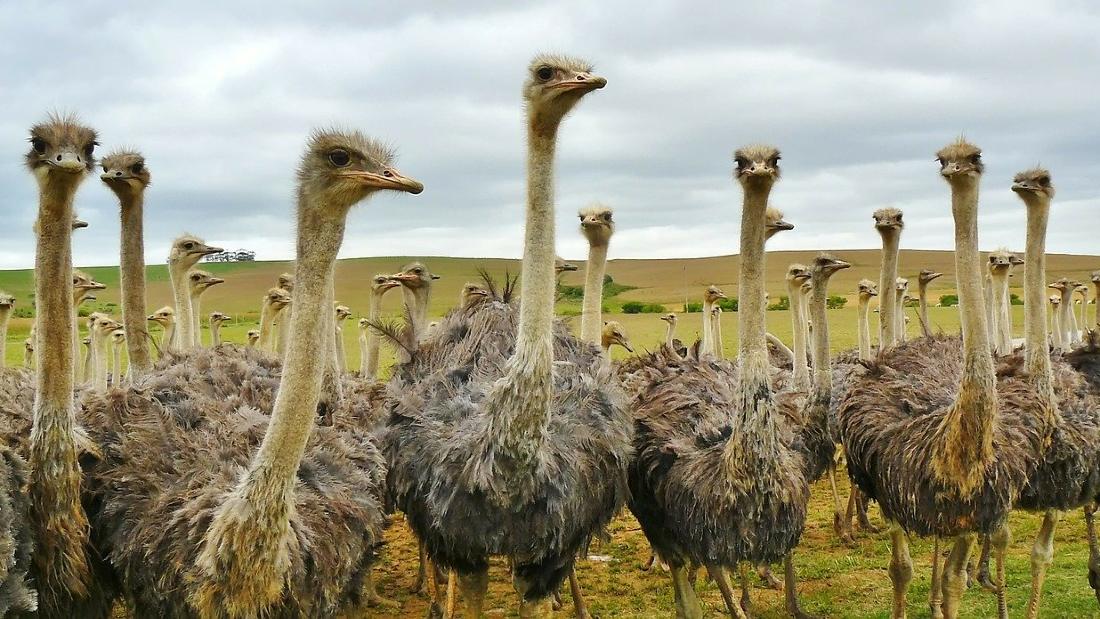
Origin
Excavated from the Green River Formation in Wyoming, the oldest fossil relatives of ostriches belong to the species Calciavis grandei, and date to the Eocene Epoch, some 56 million to 34 million years ago.1Encyclopaedia Britannica, 2020. Ostrich. Available at https://www.britannica.com/animal/ostrich [Accessed 16 July 2020].
Habitat
The birds live in woodland, shrubland, savannas and grassland across more than 25 countries in Africa.
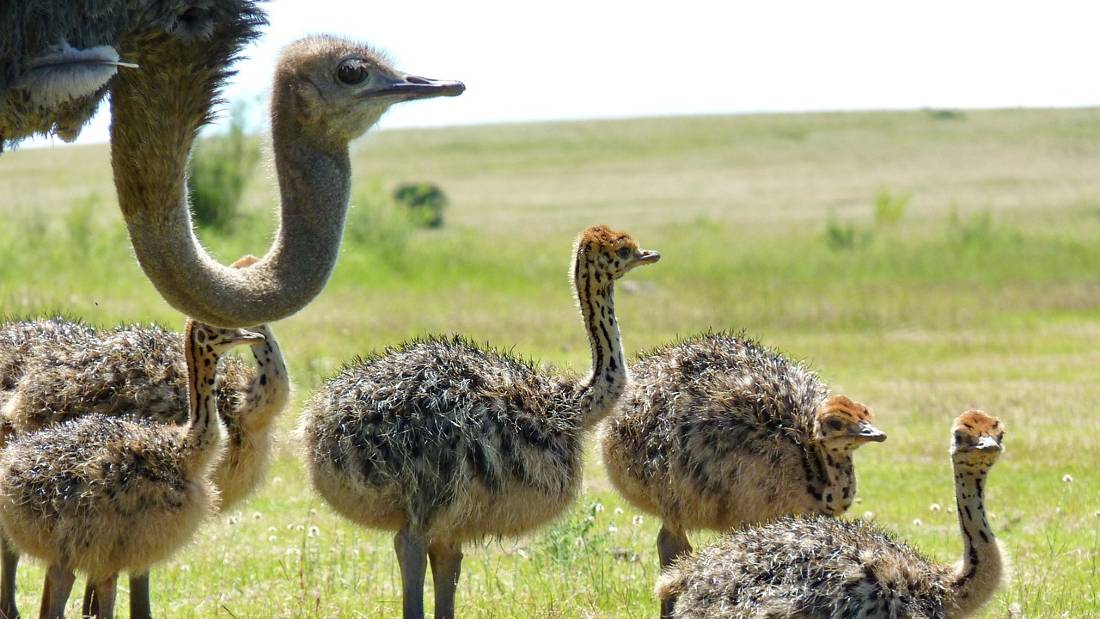
Social Groups
Ostriches spend their gregarious lives in small, scattered herds. Wild birds reach sexual maturity at four years old – farmed birds at just two to three. They can mate all year but the peak season is from autumn until spring, when the male strays away from the group with one or more females to perform the courtship ritual.
With outstretched wings, he trips the light fantastic before changing into a swaying break dance. He then crouches, sways his wings like gently lapping waves and taps his head on his back, from one side to another. A responsive female droops her wings and flutters them languidly.
The female will not lay an egg until the male has carefully formed a hollow in the ground for it. All the females in the herd then lay their eggs in this one hollow until there are 10 to 15, when the male and senior female incubate them for six weeks.
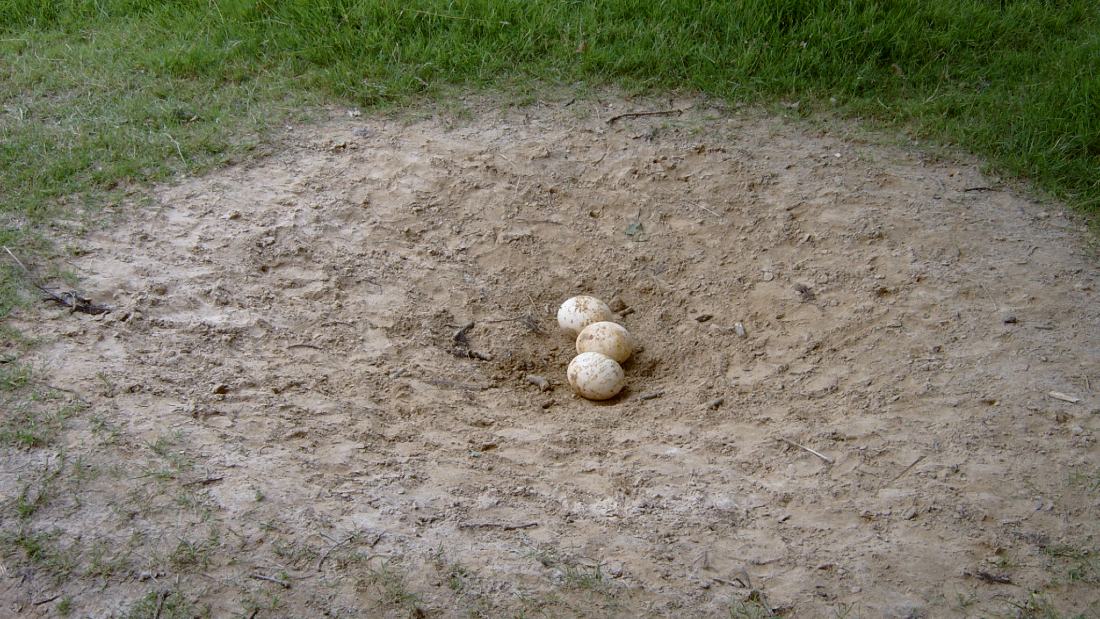
In the wild, the male ostrich is a good father and very defensive of his chicks. At the approach of an enemy, he causes a distraction by fleeing from the nest, pretending to be hurt. With limp wings he slides to the ground, seeming to collapse and repeats the performance until satisfied he has led the intruder far enough away. He then miraculously recovers and runs away at speed. The female also tries diversionary tactics but if it all fails, the male attacks furiously, lashing out with his deadly kicks.
Natural Diet & Life Expectancy
Ostriches live for up to 40 years in the wild and up to 50 in captivity.2African Wildlife Foundation, 2020. Ostrich. Available at https://www.awf.org/wildlife-conservation/ostrich [Accessed 16 July 2020]. They are omnivores but prefer plants such as grass, berries, succulents, seeds and leaves. Sometimes they eat snakes, locusts and lizards. Lacking teeth, they swallow pebbles that grind food in the gizzard.
Predators
Ostriches’ main predators are lions, cheetahs, leopards, spotted hyenas, hunting dogs and, of course, humans.2African Wildlife Foundation, 2020. Ostrich. Available at https://www.awf.org/wildlife-conservation/ostrich [Accessed 16 July 2020].
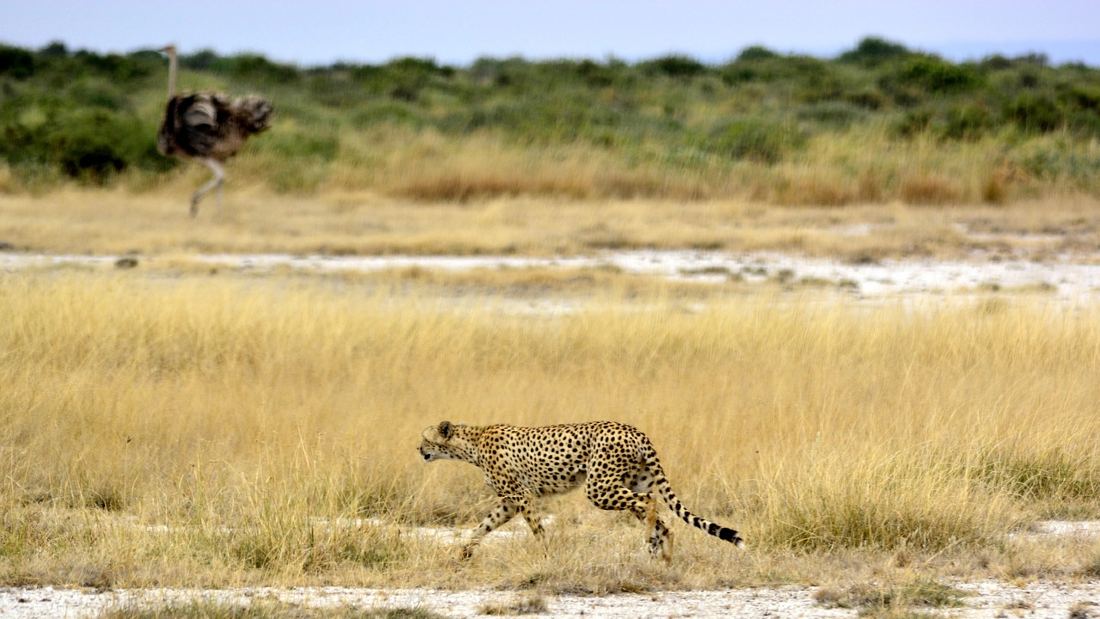
Ostriches have been farmed only since the 1860s – mainly in the Cape Colony in South Africa. Originally it was for feathers to meet the demands of European fashion. It became very profitable, with feathers ranking fourth in South Africa’s export sales. In 1914, with almost one million farmed birds, the industry collapsed virtually overnight with the outbreak of World War I. Nowadays, ostrich farms are common again in Africa, with one of the biggest being run by Mamadou Coulibaly in Malia, who earns around $1.4 million annually from it.-1Smallstarter, 2020. Ostrich farming – How this amazing business makes millions for a Malian entrepreneur. Available at https://www.smallstarter.com/get-inspired/ostrich-farming-in-africa/ [Accessed 17 July 2020].
At the end of the last century, Britain, the USA, Australia and Continental Europe started farming ostriches but this time it was largely for their meat and skin for leather fashion items. It has not become well established in Europe and has little farming infrastructure to support it. Ostrich chicks succumb readily to disease and have the exceptionally high mortality rate of 67 per cent – a much higher death rate than other farmed animals.2Adewumi, A. A., Aro, S. O. and Adeniran, S. A., 2017. PERFORMANCE TRAITS AND SURVIVAL RATE OF OSTRICH Struthio Camelus (Linnaeus, 1758) CHICKS IN CAPTIVITY. Available at https://www.researchgate.net/publication/319703463_PERFORMANCE_TRAITS_AND_SURVIVAL_RATE_OF_OSTRICH_Struthio_Camelus_Linnaeus_1758_CHICKS_IN_CAPTIVITY [Accessed 16 July 2020].
Ostriches are kept in small paddocks or pens with dozens of other birds. In nature they would be able to roam and run far distances but none of this is possible on ostrich farms. In winter, they are frequently confined to even smaller spaces, which results in stress and health issues.
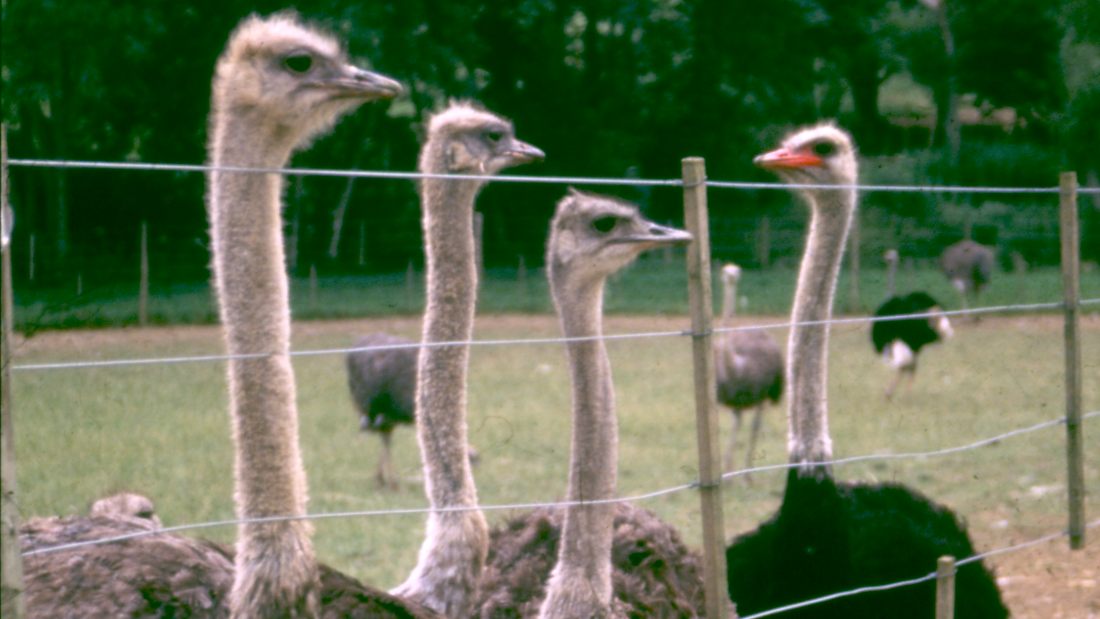
The UK government department, Defra (Department of the Environment, Food & Rural Affairs) relies on the Council of Europe’s recommendations when it comes to farming ostriches. Adult birds, they say, should have access to natural grazing during the grazing season and access to forage in winter. They are not supposed to be kept in groups larger than 40.3Council of Europe, 1997. RECOMMENDATION CONCERNING RATITES. Available at https://www.coe.int/t/e/legal_affairs/legal_co-operation/biological_safety_and_use_of_animals/farming/Rec%20ratites%20E.asp#TopOfPage [Accessed 17 July 2020].
However, it is an industry riddled with problems. A chick in the wild is never left alone by his or her parents – needing that strong sense of security as to be abandoned in the wild means certain death. As farmed chicks never see their parents, they imprint on humans who see them rarely and for only short periods leaving the chicks feeling deserted. Dr F W Huchzermeyer of the Onderstepoort Veterinary Institute explains the result:
“Whenever ostrich chicks find themselves deserted they call with a gentle “kr kr kr”. To the uninitiated it gives the impression that the birds are happy and content. Far from it, this is the sound of utter despair and distress.” (Ostrich News, Winter 1997.)
If ‘desertion stress’ is repeated often enough it triggers stomach ulcers and lowers the chick’s immune system, making him or her susceptible to disease – or they simply starve to death. Huchzermeyer explains another drawback: “Ostrich chicks reared without parents are notoriously slow to recognise their feed”. This is another cause of stress and the end result is an extraordinarily high chick death rate of 67 per cent.2Adewumi, A. A., Aro, S. O. and Adeniran, S. A., 2017. PERFORMANCE TRAITS AND SURVIVAL RATE OF OSTRICH Struthio Camelus (Linnaeus, 1758) CHICKS IN CAPTIVITY. Available at https://www.researchgate.net/publication/319703463_PERFORMANCE_TRAITS_AND_SURVIVAL_RATE_OF_OSTRICH_Struthio_Camelus_Linnaeus_1758_CHICKS_IN_CAPTIVITY [Accessed 16 July 2020].
Abnormal behaviour
Feather picking is a serious problem in ostrich farming.4Brassó, D.L., Béri, B. and Komlósi, I., 2020. Studies on Ostrich (Struthio Camelus)-Review. Acta Agraria Debreceniensis. Available at https://ojs.lib.unideb.hu/actaagrar/article/download/3772/5456 [Accessed 17 July 2020]. Birds aggressively peck feathers from each other’s backs, a problem directly brought about by stress and boredom. It is at its worst in winter when birds are subjected to even greater confinement.
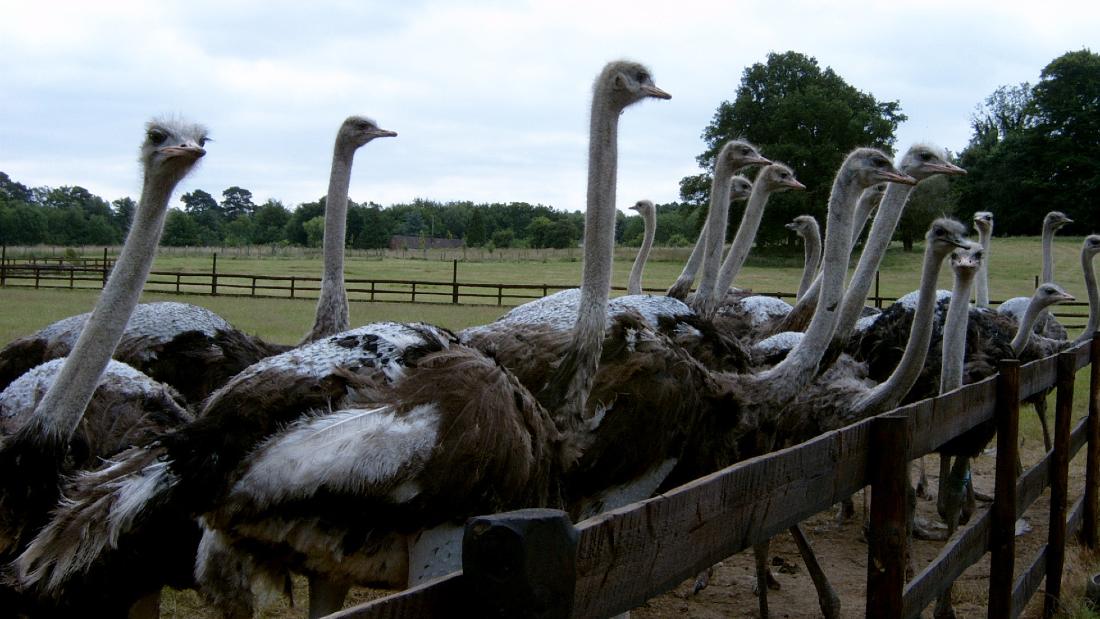
Ostriches with bald backs due to feather pecking
Housed ostriches may stargaze, lifting their heads up and back until it touches their spines. Canadian avian specialist Dr Morris Samson says: “Severely affected birds will have difficulty walking, eating and drinking because of the position of the head. Again, it’s a direct result of confinement, particularly where pens are too small and/or too dark.”5Samson, J. (1996): Behavioral problems of farmed ostriches in Canada. Canadian Veterinary Journal. Available at https://pdfs.semanticscholar.org/bdf0/cd626a70a1acae268909156ba009b0adbfe6.pdf [Accessed 17 July 2020].
The cure is simply to allow the birds outside but Dr Samson admits there is increasingly less chance of this: “If ostriches are to become a viable agricultural alternative, they will have to be reared intensively under confined environments.”
Toe and face pecking is another problem unknown in the wild. Dr Samson says: “It can lead to mutilating wounds where entire eyelids are pecked out. This aberrant behaviour is most notorious in young chicks. Although causes are unknown, it has been suggested that stress and boredom are predisposing factors.”
Fly catching is another stereotypic behaviour seen only in captive birds. They seem to be trying to catch imaginary flies and their movements are constantly repeated. Again, it is stress or pain which is the cause.
Dietary problems
It is often said by ostrich farmers that the birds are stupid because they eat anything – coins, gloves, pencils, spanners, bits of barbed wire fencing and even nails. The result is impaction or perforation and often death.4Brassó, D.L., Béri, B. and Komlósi, I., 2020. Studies on Ostrich (Struthio Camelus)-Review. Acta Agraria Debreceniensis. Available at https://ojs.lib.unideb.hu/actaagrar/article/download/3772/5456 [Accessed 17 July 2020]. The real reason ostriches do this is stress, usually caused by insufficient grazing, lack of fibre in their diet and insufficient energy intake. Taken from their mothers before they have even hatched means they have simply not been taught what to eat.6Huchzermeyer, F.W., 2002. Diseases of farmed crocodiles and ostriches. Revue scientifique et technique-Office international des épizooties, Available at https://www.doc-developpement-durable.org/file/Elevages/autruches&Emeus/Maladies/Diseases%20of%20farmed%20crocodiles%20and%20ostriches.pdf [Accessed 17 July 2020].
Breeding
The female naturally lays up to 15 eggs but farmed birds have their eggs removed so they continue to lay – 40, 70 or even 100 eggs a year. The eggs are mechanically incubated and chicks never have the protection and care of their parents.
Live transport
Ostrich transport brings at least as many issues as farming itself.
There is little science or advice on the welfare of ostriches during handling and transport. Both handlers and the birds themselves are not familiar with transport practices and what’s required. No account is taken of birds’ natural social boundaries, their sex, behaviour and physical state when mixing them together during handling and transport. In Canada and the United States, water and feed are withdrawn before transport but there is no guidance on this nor is there any specific vehicle design for these uniquely large birds. Then there is the usual story of overcrowding and long transportation times.7Bejaei,M., Cheng, K., 2014.A survey of current ostrich handling and transport practices in North America with reference to ostrich welfare and transportation guidelines set up in other countries. Poultry Science. Available at https://www.sciencedirect.com/science/article/pii/S0032579119360092 [Accessed 17 July 2020].
According to the American Ostrich Association: “Transportation is dangerous and stressful for both man and beast. Most injuries are related to activities of handling and transport.” These disturbing events make the birds “unsettled and nervous”. It also begs the rhetorical question, what do you think happens to a bird standing on two legs if you slam on the brakes? Fighting, pecking or stepping on one another causes injury or even death, particularly if loaded too tightly.
Ostriches are not only transported to abattoirs but breeding birds are subjected to live export. They have been seen being loaded onto ferries at Dover and Hull and arriving from Belgium. One observer saw 165 birds being loaded onto a trailer and described it for us: “Seventeen birds were in the back compartment, about 8 x 12 square feet. Several birds jumped into each other and tried running through the wall while crying a high-pitched scream.”
First-Hand Accounts
Cherylynn Brown took pictures of the following scenes at Brandywine Ostrich Farms in Hemet, California and made these observations:
- Birds standing with black cloth wrapped around their faces.
- A person holding a 10-foot, metal-hooked pole while another helps him corner the ostriches. They try to put black cloth tubes over the bird’s heads but even the blindfolded ones try to run.
- As the ostriches are forced towards a truck, they jump and try to run, swinging the farm workers round. The workers hold onto their tail feathers, ripping them out by the handful, or they grab the birds by the face or beak and wrestle them into a neck hold and force them into the truck.
- I see ostriches fighting a handler called Chip and his helpers as they push them onto the truck. One ostrich called Schizy sheds her mask and struggles away from the handlers.
- Chip is angry at her as she sits down and refuses to get up. He kicks her several times in the thigh. She cries but does not attempt to stand.
- He grabs her wing and tries to lift her. She refuses. He kicks her in the behind. She cries but stays sitting. Chip and another worker pull on her wings and neck but she will not move.
- So Chip and two workers push her to the opening of the truck door as she sits on the ground. They put their hands under her feet and lift. She kicks and they grab her body and wings and force her on the truck. She sits hanging off the side of the door. They push her in most of the way and use the door to push her the rest of the way. A bunch of tail feathers are caught in the door and are hanging out as the truck drives away.
Diseases
Ostrich specialist F W Huchzermeyer identifies a range of diseases in farmed ostriches, including avian influenza and enteritis. The latter is caused by chicks being reared on concrete floor and not being able to develop their normal intestinal flora, together with the administration of antibiotics.6Huchzermeyer, F.W., 2002. Diseases of farmed crocodiles and ostriches. Revue scientifique et technique-Office international des épizooties, Available at https://www.doc-developpement-durable.org/file/Elevages/autruches&Emeus/Maladies/Diseases%20of%20farmed%20crocodiles%20and%20ostriches.pdf [Accessed 17 July 2020]. He says that most of the mortality in farmed ostriches is due to their poor rearing conditions.
Clive Madeiros, of Banbury Cross Veterinary Practice, who used to specialise in farmed ostriches and wrote for Ostrich News (magazine of the British Domesticated Ostrich Association) says: “The single most common problem seen on all ostrich chick farms is feet and leg troubles…….the unique anatomy of the ostrich, along with its rapid early growth – 30cm from day old to 2m within five to six months – make them particularly prone to feet and leg problems.” (Ostrich News, Spring 1996.)
Poorly formed bones lead to dislocated joints and fractures as a result of living conditions – chicks running into obstacles because of boredom or losing their footing on slippery, muddy surfaces. Mr Madeiros says: “The ostrich is very sensitive to joint, ligament, tendon and skeletomuscular pain and injuries in this area often lead to lameness, loss of appetite and depression. These secondary symptoms can themselves often lead to death.”
As with broiler chickens, high protein feeds can also cause leg problems. The feed makes the birds grow so fast that their young bones become deformed under their excessive weight.
Ostriches are usually killed at eight to nine months old.1British Domesticated Ostrich Association, 2006. WOA Benchmark Performance Targets. Available at http://www.ostrich.org.uk/industry/benchmark.html [Accessed 20 July 2020].
The Humane Slaughter Association stresses the danger involved when handling ostriches. Their forward defensive kick can easily disembowel handlers. Most ostriches are killed in abattoirs by head-only electrical stunning, followed by bleeding, which requires at least four workers to hold the bird down. The other suggested slaughter technique is to kill the birds in a field with a captive bolt pistol followed by pithing (inserting a rod through the hole in the bird’s head and stirring the brain around) and bleeding. Killing by using a shotgun has proved unsuccessful.2Humane Slaughter Association, 2011. Slaughter and Killing of Minority Farmed Species. Available at https://www.hsa.org.uk/downloads/technical-notes/TN25-minority-farmed-species-slaughter.pdf [Accessed 20 July 2020].
Undercover investigators have filmed the brutal handling and killing of ostriches in South Africa. During transport workers were seen brutally kicking the birds’ heads3Logan, R., 2016. Graphic video shows how ostriches are killed in slaughterhouses for luxury handbags and shoes. Mirror. 27 February. Available at https://www.mirror.co.uk/news/world-news/graphic-secret-video-shows-how-7452874 [Accessed 20 July 2020]. and once at the slaughterhouse, they were roughly man-handled to a big restraining machine. Birds fell over and were clearly distressed.
Other slaughterhouses use leg-clamps to restrain the highly-distressed birds before they are electrically stunned to the head. Done correctly, 90 per cent of birds are rendered unconscious by this.4Wotton, S., Sparrey, J., 2002. Stunning and slaughter of ostriches. Meat Science. Available at https://www.researchgate.net/publication/51777816_Stunning_and_slaughter_of_ostriches [Accessed 20 July 2020]. The other 10 per cent – and very likely many more – are cut open while conscious due to inexperience of slaughterhouse workers.
Ostrich industry
At the end of the 1990s, there were around 400 ostrich farms in the UK.5Wallerstein, C., 2000. Flash in the pan. The Guardian. 31 March. Available at https://www.theguardian.com/theguardian/2000/mar/31/features11.g21 [Accessed 20 July 2020].
The British Domesticated Ostrich Association (BDOA) estimated there were 5,000 breeding hens, which should have produced 100,000 slaughter birds, amounting to 3,000 tons of ostrich meat in 1997. The price varied from £9 to £15 per pound.6British Domesticated Ostrich Association, 2020.Economics and Commercialisation of Ostrich Production. Available at http://www.ostrich.org.uk/industry/economics.html [Accessed 20 July 2020].
However, there was simply no market for such a quantity of meat, particularly when Tesco, Sainsbury’s, Asda and Somerfield withdrew from the trade following Viva!’s highly-effective campaign against the industry. In 1997, the birth of Osmarque was fanfared – the Ostrich Meat Marketing Company – in an attempt to reverse the flagging sales of ostrich meat. .
Following Viva!’s successful campaigns against ‘exotic’ meat and the difficulties of commercially farming the big birds, the industry never managed to take off. Now only a few farmers are still rearing ostriches and selling them for their meat, their skin and feathers. Ostrich News, the newspaper of the BDOA, blamed Viva! for the near eradication of ostrich farming in the UK. The virtual death of the industry was announced in 2011 by Ostrich News.
The conclusion drawn by Ostrich News was:
“It is difficult, due to the lack of processing infrastructure currently available to make farming ostrich a viable activity in the UK. It undoubtedly can be done but any prospective farmer needs to thoroughly research the slaughter/processing facilities in their chosen area and also be prepared to undertake direct marketing of the meat. This situation will continue until a substantial investment in production and provision of associated infrastructure is undertaken.”
That investment never arrived and currently just a few small-scale ostrich farms operate in the UK.
Healthy Alternative?
Retailers claim that ostrich meat is a healthy alternative to beef. However, ostrich is NOT low in cholesterol but has 57mg per 100g – almost the same as beef. In light of the most recent research linking meat to cancer, ostrich can be considered in the same health-threatening category as other red meats.
Ostrich meat can transmit many diseases to humans including salmonella, E coli and campylobacteriosis. It decays incredibly rapidly and its fast deterioration allows bacteria to flourish.
Viva! launched a major campaign against the trade in ostriches in October 1996, firstly focussing on Tesco. In September the following year, in response to our campaign, Tesco withdrew all ostrich meat from its stores. In mid-1998, the British Domesticated Ostrich Association acknowledged Viva!’s success, stating: “In the past we had employed a PR agency to counter the Viva! campaign which has caused damage to the industry but due to costs the Association had to drop the use of a PR agency. (Ostrich Talk, 7:2, summer 1998.)
Due to Viva!’s campaigning against ‘exotic’ meats, Booker Cash & Carry withdrew from selling ostrich meat in 1997. That year Somerfield also stopped their introduction of ostrich meat in 520 stores. Asda also conceded. In February 1999, Waitrose announced they were stopping selling ostrich after a three-year campaign by Viva!, as we were driving to a photo call outside their flagship store! We turned a Day of Action for Ostriches we had planned into celebratory photo calls.
Members of Viva!, dressed in dull grey suits and with sand buckets over their heads, were to carry the slogan – ‘Waitrose management – hiding from ostrich cruelty’. It was to be followed by a national day of action against Waitrose by Viva! groups across Britain on Saturday 27 February. Waitrose conceded defeat just half-an-hour before the press call.
Juliet Gellatley, Viva! Director, says: “This is the final victory for wildlife against the big supermarkets. Tesco, Somerfield, Morrisons, Asda, Sainsbury, Booker Cash & Carry and now Waitrose – one by one they have all dropped ‘exotic’ meats as Viva! has focused public attention on their cruel trade in wild animals. We have no hesitation in claiming Waitrose’s decision as our final victory in this campaign, which has been fought at a local level all over Britain. The vast majority of the general public has been behind us – disgusted by the sale of kangaroo, alligator, crocodile and ostrich meat.”


